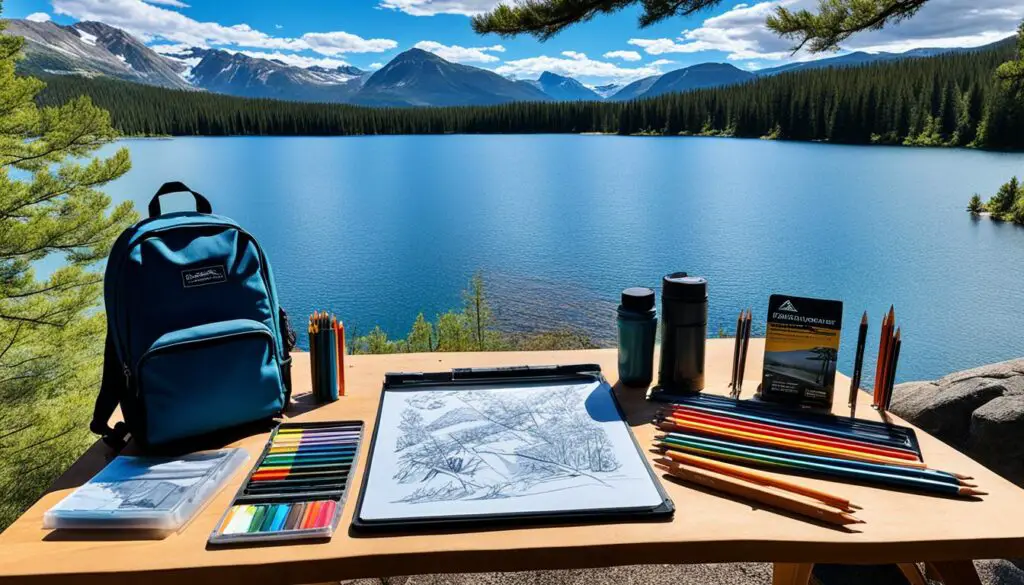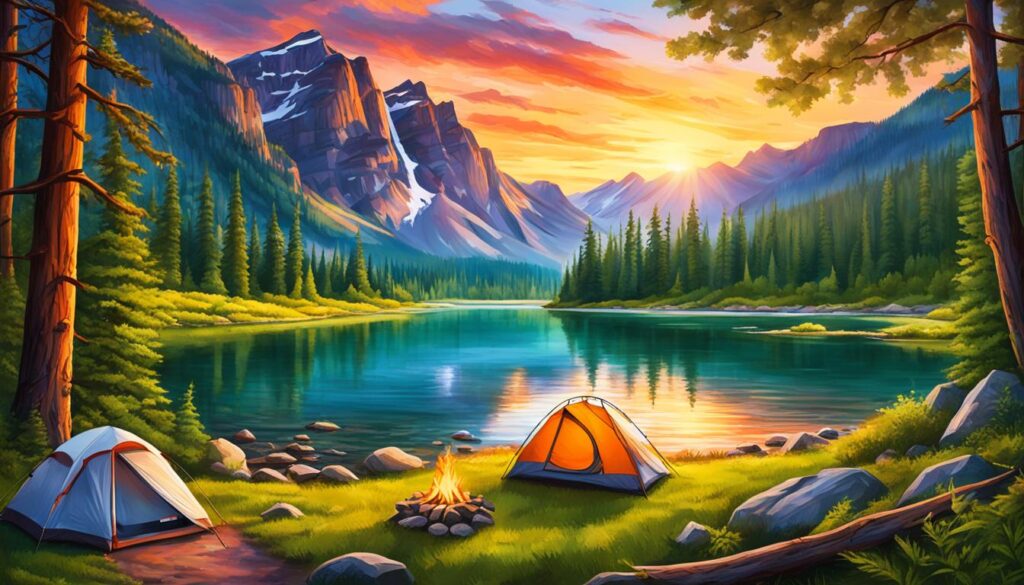Camping Drawing Step by Step
Unlock your artistic potential and dive into the beauty of nature with this guide. Whether you’re a pro or just starting, you’ll master drawing camping scenes. This skill turns your outdoor memories into beautiful artworks.
Learn to draw peaceful landscapes and nature’s details with my steps. Start a journey where your camp’s beauty meets your creativity. The result will be amazing art pieces that you’ll love for life.
The Joy of Camping and Drawing
Connecting with nature through outdoor art and nature drawing is fulfilling. It’s inspiring when you’re on a camping trip. Doing art helps you capture what’s beautiful about camping.
Combining Nature’s Beauty with Creative Expression
The outdoors has a lot to offer to anyone who likes to draw. You can find inspiration in large landscapes or small details like plants and animals. Every camping trip is a chance to be more creative.
Sketching nature lets you slow down and really see it. You take time to look and put what you see on paper. This makes you feel calm and connected to the outdoors.
Drawing outdoors changes how you see the world. You learn to appreciate nature more by drawing it. It makes you want to look at the world with fresh eyes every day.
So, take joy in camping and drawing. Let the natural beauty start your creative journey. Every drawing you make brings you closer to the world.
Essential Supplies for Outdoor Sketching
Getting the right tools is vital for drawing outside. For those who love camping and nature, I will help you pick the must-have art items. This starts with finding the best sketchbook and drawing tools. I’ll make sure you’re ready to draw your favorite spots outside.
A top-notch sketchbook is where you should begin. I suggest the Laws Sketchbook for Nature Journaling or the Stillman & Birn Alpha Series. They are tough and have great paper for any art style.
Then, let’s look at what to draw with. The Prismacolor Col-erase Non-photo Blue Pencil is great to start your sketches. You’ll also want mechanical pencils in 0.5 mm and 0.7 mm for quick drawings. A 0.3 mm pencil is best for fine lines.
Don’t forget about erasers. Have a kneaded eraser, a white vinyl eraser, and a small, fine-tip eraser ready for different needs.
- Kneaded erasers blend pencil marks well.
- White vinyl erasers erase cleanly.
- Small, fine-tip erasers are for detailed work.
Pens are handy too. Try Pigma Micron pens, fiber-tip pens, or smooth brush pens. These tools let you play with different drawing styles.
When it comes to color, grab Prismacolor Premier or Faber-Castell Polychromos colored pencils. These are top picks for quality. Use elastic bands to keep them neat and easy to use.
And for a unique touch, pack watercolor pencils. They turn into paint with water. With these items, you’re set to draw stunning pictures of nature.

Mastering the Fundamentals of Nature Drawing
Are you someone who loves camping? Learning to draw nature can make your outdoor moments even better. You might be drawn by the beauty of hills or focused on tiny wildflowers. The skill of drawing nature helps you deeply feel a part of your environment.
Capturing Landscapes, Flora, and Fauna
To start drawing nature, you must learn some key techniques. Understanding these basics will help you express the world’s beauty on paper.
- Linear Construction: Making a base with straight lines is key. It helps get the shape and size of things right. You keep improving until your drawing looks just like the real thing.
- Value Matching: Try squinting your eyes when you draw. This trick cuts out extra details. It improves your skill at capturing light and shadows, making your work more real.
- Understanding Light: Knowing how light hits things makes a big difference. It helps add depth to your drawings. Paying attention to light and shadow makes your art come to life.
These techniques will help you draw the beauty around you while camping. Practice a lot and really look at what’s in front of you. This is how you get good at drawing from nature.
| Technique | Description | Importance |
|---|---|---|
| Linear Construction | Using straight lines to outline the subject’s shape | Key for making an accurate drawing |
| Value Matching | Squinting to see values more clearly when you draw | Makes your drawing look deeper and real |
| Understanding Light | Watching how light and shadows change a subject | Helps you create a 3D effect in your work |
With these skills, you can turn what you see while camping into beautiful drawings. Your sketches will be lasting memories. Drawing nature brings joy and boosts your creativity!
For more on outdoor drawing, check out Instructables, Keshart Drawing Camp, and the Virginia 4-H Camp Curriculum Guide. These are great places to learn more and improve your drawing skills.
Camping Drawing Step by Step
Ready to start drawing? I’ll show you how to make stunning camping scenes step by step. First, set up your drawing spot. Then, let’s draw the scene’s different parts. You’ll have what you need to turn your outdoor memories into art.
Are you new to drawing or already love it? This guide is for you. You’ll get better at sketching nature. Learn to draw mountains, trees, and more. Make your pictures come to life.
Follow these simple steps to draw what you saw and felt on your trip. Let your creativity flow. Turn your memories into beautiful drawings. You’ll love what you create.
FAQ
What are the essential art supplies I need for outdoor sketching?
Start with a top-notch sketchbook and drawing pencils from 2H to 6B. Don’t forget a good eraser and sharpener. Also, a small set of colored pencils or watercolors should be in your kit. A portable easel or drawing board will make your work steadier.
How can I capture the beauty of landscapes in my drawings?
When drawing landscapes, aim to show the whole scene and how light and shadow play. Block in the major shapes and proportions first. Then, slowly include details and textures. Focus on the horizon and how it affects depth.
What techniques can I use to sketch flora and fauna accurately?
To draw plants and animals well, watch their shapes and unique parts. Start with basic shapes and add finer details later. How your tools are can really affect your drawing’s detail level.
How do I set up my workspace for outdoor sketching?
Having a good, comfy space for sketches outside is key. Pick a place with a clear view and good light. A stable surface like an easel is a must. Bringing a stool helps you stay comfy while working.
What are some tips for creating a sense of depth in my camping drawings?
For depth in your drawings, use overlapping shapes and different shades of light and dark. This makes your scene look “deep.” Also, put objects at different distances to get a real sense of space. Change object sizes to show distance from the viewer.
- Discover the 4 Must-Have Camping Tent Accessories for Spring 2025 - March 19, 2025
- Why Camping Is Bad - November 29, 2024
- Best Camping Knife - November 29, 2024
